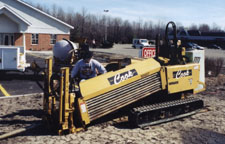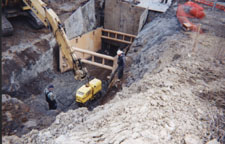by Diana Barnum, Ron White, and Michael
Princic
Correspondents
Cook Paving and Construction Co., Inc. of
Brooklyn, Ohio, recently had to handle a couple of problems for their
clients. It took a little creativity, but the results went over big with
their clients.

One client was constructing a building in a newer shopping plaza and
realized that they had left out gas service going to the building after
the driveway had already been installed.
Was there a way to insert a
305-foot service line without tearing out the only entrance? That entrance
allowed access to parking near their building and neighboring buildings
that were already open.

Cook Paving examined the site. They found that they would also have to
bore through an existing 200-foot landscape mound planted with a variety
of trees and shrubs and cross a sidewalk at the street. Since they could
not place the line in a relatively straight path, and wanted minimal
disruption, their only answer was horizontal directional drilling
(HDD).
Placing the "One Call" to have existing utilities in the area
marked, Cook Paving began the work. They'd noticed some power and
telephone cable coming down a pole near the site and knew the end point
was a gas main at the street.
After a 48-hour waiting period for
markings, they mobilized their Vermeer D7 X11a Navigator HDD drill from
Vermeer Sales & Service, Inc. of Medina, Ohio. The drill is
self-contained with 1,100 ft-lb max torque, pullback of 7,800 lbs., 9 gpm
mud flow, 198' stem-carrying capacity, and 6' drill stem.
Onsite, they
laid out a bore plan and tracked the machine to the starting point on
plywood. Tearing up the sod was not necessary. Then they hand-excavated
three pits: one at the front of the drill, one to expose power cables that
they would cross and one at the end of the bore over the top of an
existing gas main.
Cook Paving was able to drill out successfully on
target and pull in the gas line in less than a day without taking out any
concrete pavement or damaging any landscape. There was no disruption of
traffic and the only restoration work needed was four square feet of grass
where they'd dug their splits. The total bore was 305 feet.
"This was
by no means a big job for us," said Ron White, trenchless technology
division manager. "It was good to be able to solve a customer's problem
beyond their expectations at estimated savings of over 50% under
traditional open-cut excavation methods by employing the right technology
for the job."
Soil Compaction
Around that same time, Cook
Paving installed conduit for First Energy under the SR 237 off ramp IR 480
westbound. This particular area involved a 36" casing bore under the ramp
at a depth of 28' on a hillside. The excavation required large, stacked
trench boxes and banks cut back to assure safety. After completion of the
bore and tie in of the conduit, restoration was required so that material
would not settle or slide down onto the traffic lane.
First they
backfilled the areas inside the boxes and compacted in 8" to 10" lifts
with EZ-Mud from Baroid. Compaction was done with a remote-controlled
Wacker RT80, 33" sheeps' foot vibratory compactor.
Then they lifted
out the boxes as each layer was installed to ensure that the banks did not
collapse into the excavation. After all boxes were removed, Cook Paving
removed the balance of the excavation and they backfilled the surrounding
area in 1-foot lifts, compacting with an Ingersol Rand SD 100
self-propelled sheeps' foot roller. Then they fine graded the area to its
original contours and slopes and seeded.
Although there were no
specifications on this project requiring compaction or compaction testing,
there were safety concerns as well as cost of returning to repair the area
again.
"If restoration is poor and the ground is settling, the client
may wonder what the contractor did with what can't be seen," said Michael
R. Princic, superintendent of Cook Paving. "Compaction should be viewed as
a very important part of any project."
Cook Paving and Construction
Co., Inc., headquartered in Cleveland, Ohio, was founded in 1950 by Montry
C. Cook. They operate satellite locations throughout Northeastern Ohio,
providing service to private and municipal, state and federal agencies.
Their areas of expertise include asphalt, concrete, site development,
construction and project management, telecommunications and utility
construction.
Cook is a union company and is a Certified Minority
Business Enterprise (MBE) with the Ohio Departments of Administrative
Services, the Ohio Department of Transportation, the City of Cleveland,
Cuyahoga County, and other public agencies. They are also certified in the
8(a) program of the U.S. Small Business Administration.
For more
information, contact Cook Paving and Construction Co., Inc., 11360
Brookpark Road, Suite 212, Brooklyn, Ohio 44130-1111. Call: (216)
267-7705, or fax inquiries to (216) 267-7595. |